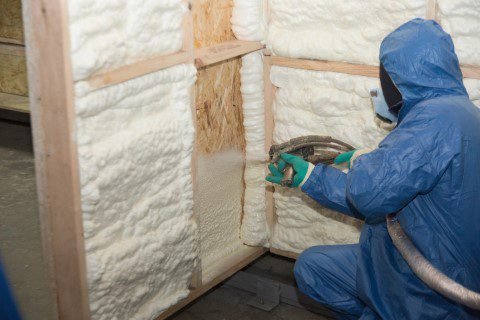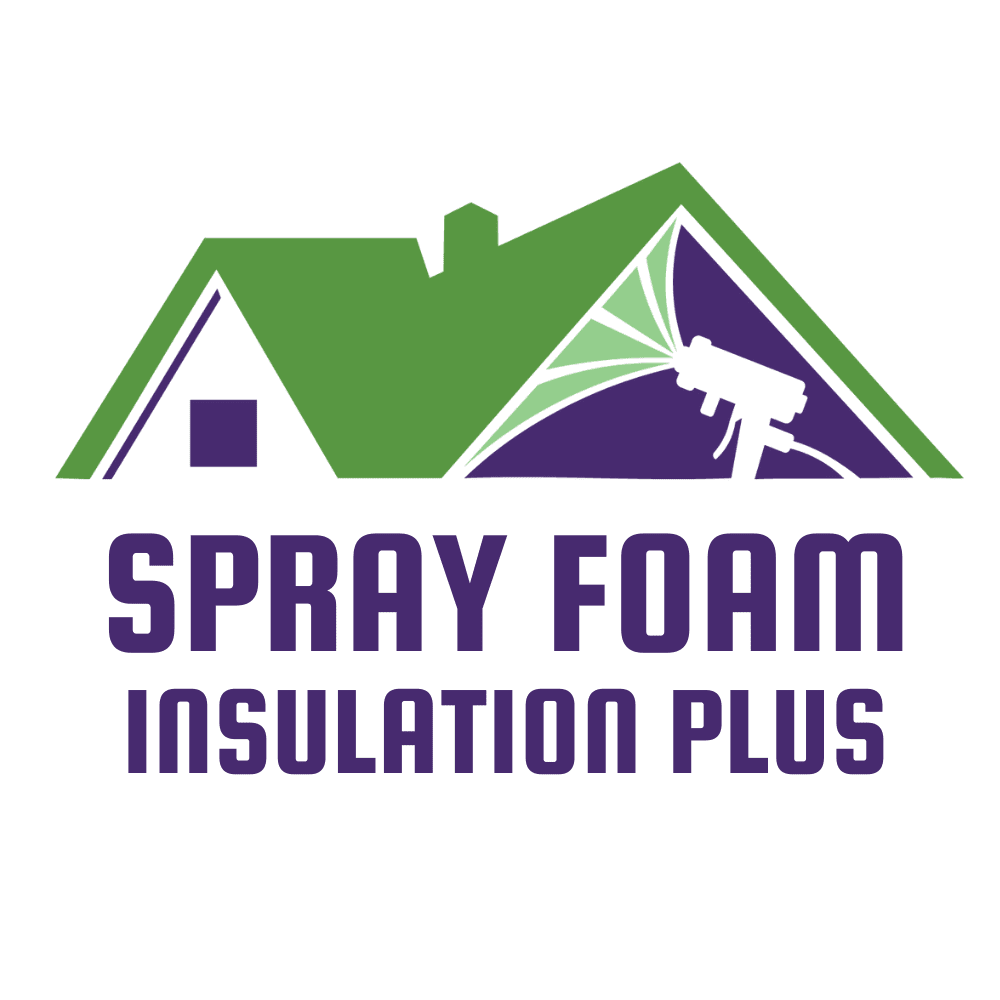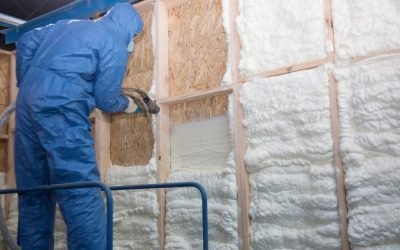Open-Cell vs Closed-Cell Spray Foam Insulation

Last Updated on July 30, 2024 by Spray Foam Insulation Plus
Open-cell and closed-cell spray foam insulations function uniquely in various environments. Open-cell foam, less dense and flexible, is revered for its sound-absorbing qualities making it optimal for interiors. Yet, closed-cell foam’s superior density presents a hardy resilience to moisture and capacity for structural reinforcement, fitting it well for outdoor spaces or areas with potential water exposure. But here’s a nugget of wisdom – while these generalizations hold true, your project’s location, climate conditions, regulatory building codes, and even budget may tip the scales in favor of one over the other.
The main differences between open-cell and closed-cell spray foam insulation lie in their density, permeability, and R-value. Closed-cell foam is denser, has a higher R-value, and acts as a vapor barrier, while open-cell foam is less dense, allows for vapor permeability, and provides sound dampening properties. Understanding these differences can help homeowners choose the best option for their specific insulation requirements.
Exploring Open-Cell and Closed-Cell Spray Foam Insulation
When it comes to choosing between open-cell and closed-cell spray foam insulation, each type has its own strengths. Open-cell spray foam insulation is often used for interior applications because of its flexible nature and sound-dampening properties. It’s like the superhero inside your walls, making sure that your home isn’t too loud to live in but also stays warm when it needs to.
Its flexibility means it can expand and contract according to the changing temperatures which makes it perfect for places where there’s a risk of swelling or shrinking, like within wooden frames. Not only does it provide thermal insulation, but it also helps maintain the structural integrity of the building over time.
On the other hand, closed-cell spray foam insulation is like an unyielding shield. Its tightly packed structure gives it strength, providing structural reinforcement to the building. This type is generally preferred for outdoor use or areas prone to water exposure due to its ability to resist moisture. The dense structure also forms a barrier that effectively blocks air infiltration, making it a powerhouse in energy efficiency.
Imagine open-cell as your fluffy winter hat, keeping you cozy with soft material, while closed-cell is like a sturdy raincoat that shields you from harsh weather conditions – each serving their distinct roles.
When deciding which type of spray foam insulation is best for your project, it’s essential to carefully consider the specific needs of the area being insulated. The application area, budget constraints, environmental factors, and desired insulation performance all play pivotal roles in this decision-making process.
It’s akin to choosing between different tools in a toolbox; one may be just right for a particular task while another might be better suited for a different job. Making an informed decision based on your specific project requirements will ensure that you harness the full potential of either open-cell or closed-cell spray foam insulation for maximum benefit.
Comparative Analysis: Open-Cell vs Closed-Cell Foam
In the realm of insulation materials, the choice between open-cell and closed-cell foam can significantly impact your home’s energy efficiency, comfort, and long-term structural integrity. Each type of foam possesses its unique set of qualities, and it’s indispensable to consider these features in relation to your specific needs and the characteristics of your home.
Open-Cell Foam
If you’re aiming for a more flexible and cost-effective solution, open-cell foam might be the better fit. Its lighter density provides excellent soundproofing capabilities, making it a popular choice for interior applications like walls and ceilings. Due to its high flexibility, open-cell foam is easier to install and allows for expansion and contraction in changing temperatures, effectively preventing cracks or gaps from forming over time.
Closed-Cell Foam
On the other hand, closed-cell foam offers higher structural strength and enhanced water resistance due to its denser composition. It’s well-suited for outdoor use, providing superior protection against moisture infiltration. Its rigidity also lends itself to added support for buildings, making it ideal for use in areas prone to severe weather conditions.
In terms of installation, open-cell foam is less demanding and can be applied by DIY enthusiasts. However, closed-cell foam demands professional installation due to its specific application requirements and the specialized equipment needed for proper application.
For instance, if you’re residing in a region with strict building codes or extreme climate conditions, closed-cell foam might be worth considering for its added durability and resistance. However, if you’re working on an interior project where soundproofing is a priority, open-cell foam’s flexibility makes it an excellent choice.
Ultimately, determining which type of foam is best suited for your needs involves weighing various factors such as your location, local building codes, climate patterns, and budget constraints. By carefully evaluating these considerations, homeowners can make an informed decision that aligns with their specific requirements while ensuring long-lasting benefits for their homes.
A Closer Look at Air Sealing and Heat Properties
When insulating your home, ensuring thorough air sealing is crucial for maintaining energy efficiency. Open-cell foam, known for its lower density, has a reduced resistance to heat transfer compared to closed-cell foam. Conversely, the dense structure of closed-cell foam provides an exceptional air barrier and higher R-value, rendering it significantly more effective in preventing air leaks and offering superior insulation against heat transfer.
Air sealing is crucial because even tiny cracks or gaps in walls and roofs can allow air to escape from your home, making it harder to maintain the desired indoor temperature. Closed-cell foam acts as a durable shield against the infiltration of outside air, trapping conditioned air indoors.
In terms of closed-cell foam’s R-value – a measure of its thermal resistance – its higher R-value enhances its ability to resist heat flow through walls and other structures, thereby providing better thermal protection. This indicates that closed-cell foam not only surpasses open-cell foam in terms of airtightness but also outperforms it in thermal insulation capabilities.
However, it’s important to consider that each type of foam has its unique advantages and applications based on specific project requirements.
As the preferred choice for comprehensive air sealing and enhanced energy efficiency, closed-cell foam stands out for its ability to provide a superior barrier against both air leakage and heat transfer, contributing significantly to reduced energy costs and improved indoor comfort.
Imagine insulated walls built with closed-cell foam – they not only have minimal potential for air leaks but also provide robust thermal resistance, preventing heat from escaping during colder seasons or infiltrating during warmer months.
Understanding the differences in air sealing and heat properties between open-cell and closed-cell foam enables homeowners to make informed decisions when considering insulation options for their homes.
Equipped with an understanding of the essential factors differentiating open-cell from closed-cell foam insulation, our journey leads us to explore another pivotal consideration—insulation R-value. The variation in R-value between open-cell and closed-cell spray foams is often a deciding factor for homeowners looking to optimize energy efficiency and comfort.
Understanding Insulation R-value: Open-cell vs Closed-cell
When insulating your home, one of the most critical factors to consider is the R-value of the insulation material. The R-value measures a material’s resistance to heat flow, or more simply put, how well it insulates. Spray foam insulation is known for its excellent R-value, making it one of the most effective types of insulation available.
Closed-cell foam, in particular, offers higher thermal resistance compared to open-cell foam. It typically has an R-value of about 6.0 to 7.0 per inch, whereas open-cell foam has an R-value of around 3.5 to 3.7 per inch. This means that closed-cell foam is more efficient in its ability to resist heat flow, making it a superior choice for areas with limited space or where maximum insulation performance is essential.
If you live in a region with extreme weather conditions, such as very cold winters or hot summers, using a material with a high R-value like closed-cell foam can significantly reduce your heating and cooling costs while keeping your indoor environment comfortable.
In addition to its higher R-value, closed-cell foam also possesses water-resistant properties due to its dense structure. This characteristic makes it an ideal choice for applications in areas prone to moisture exposure, such as basements or crawl spaces. Water can greatly reduce the effectiveness of insulation over time, so this feature adds to the longevity and performance of closed-cell foam.
Understanding these differences in insulation R-values between open-cell and closed-cell spray foam helps homeowners make informed decisions regarding their insulation needs based on their specific requirements, budget, and environmental conditions.
By comprehensively understanding the attributes of different insulation materials, homeowners can make well-informed choices that cater specifically to their unique needs and climate conditions.
Influence of Water Absorption and Condensation
Understanding how spray foam insulation deals with water is crucial because moisture can create serious problems. When it comes to open-cell vs. closed-cell spray foam insulation, their responses to water absorption are quite different.
Open-cell spray foam, due to its semi-rigid structure, can absorb and retain water if exposed to moisture. This can lead to a reduction in its insulating properties and potentially promote the growth of mold. The trapped water within the open-cell structure not only makes it less effective but also creates conditions that are perfect for mold development.
On the other hand, closed-cell foam’s tightly compacted structure prevents it from absorbing water. It is effectively impervious to moisture, making it a suitable choice for areas where exposure to water is a concern—think of basements, crawl spaces, or even exterior insulation.
Imagine your home’s exterior insulation—the last thing you want here is for the insulation to absorb water like a sponge, which could lead to structural damage and degradation over time. This is where choosing closed-cell spray foam provides peace of mind since it won’t let moisture seep in and cause any harm.
Water damage can be extremely costly to repair and result in long-term structural issues if left unaddressed. Preventing such issues is a key reason why many homeowners opt for closed-cell spray foam in areas where moisture exposure is a concern.
In areas where moisture isn’t an issue, or where proper vapor barriers and flashing techniques are in place to protect the insulation from moisture exposure, open-cell foam might still be a viable and cost-effective solution.
It’s important to make this decision with careful consideration of the specific environment where the insulation will be used. By doing so, homeowners can avoid future headaches by choosing the most suitable type of spray foam insulation for their needs.
Cost Implications of Open-Cell and Closed-Cell Foam
When examining the cost implications of open-cell and closed-cell foam, it’s essential to look beyond the initial investment. While open-cell foam tends to be more budget-friendly per cubic foot compared to closed-cell foam, you must also weigh other important factors. The capability of closed-cell foam to provide a higher R-value and stronger resistance to moisture may result in long-term benefits that could outweigh the initial costs. It’s not just about the bottom line; it’s about investing in the future durability and efficiency of your property.
Project size, location, and specific insulation requirements are critical factors to consider when evaluating the cost implications of each type of foam. Smaller projects may benefit more from the cost-effectiveness of open-cell foam, while larger projects might find better long-term value in choosing closed-cell foam due to its superior performance in various conditions. Deciding on the right type of foam for your project depends on these key considerations—there’s no one-size-fits-all solution.
To make a well-informed decision, it’s important to consult with a professional insulation contractor who can assess the cost-effectiveness based on individual project needs and long-term performance. Their expertise and experience will help you navigate through the trade-offs and make informed choices about your insulation investment.
It’s crucial to recognize that selecting the right type of foam for your insulation needs isn’t just about the immediate cost—it’s about achieving the best balance between short-term affordability and long-term performance. Making an informed decision requires considering a multitude of elements particular to your project.
Ultimately, by consulting with professionals like our team at Spray Foam Insulation Plus, you can gain personalized insights and recommendations that steer you toward making the best choice for your unique situation.
If you’re in need of expert guidance on spray foam insulation or have questions about selecting the right type for your specific project, don’t hesitate to reach out to our experienced team at Spray Foam Insulation Plus or give us a call at 612-730-9417. Our experts are ready to provide you with insights tailored to your requirements, ensuring that your insulation decision is well-informed and beneficial for years to come.

Tags
Preferred Contractors of:



